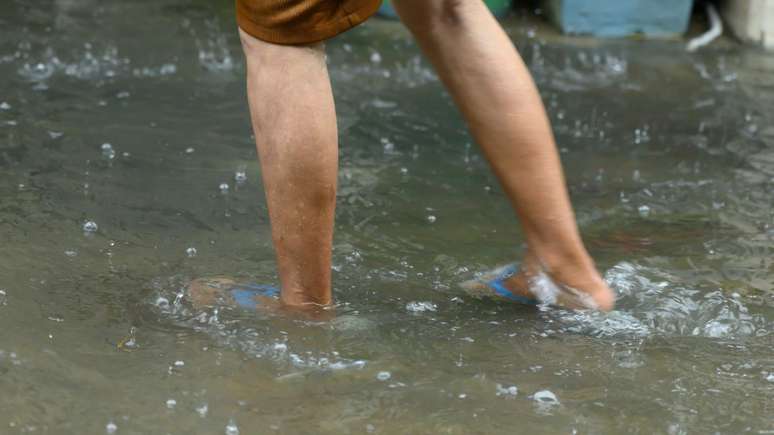There are many doubts about the disease and many believe that, to contract the disease, it is necessary to have an open wound and be in direct contact. Will be?
The floods in my land, Rio Grande do Sul, has caused deaths and now threatens people’s health. Last Monday (05/20/24), the State government confirmed the first death of leptospirosis. There are many doubts about the disease and many believe that, to contract the disease, it is necessary to have an open wound and be in direct contact. Will be?
Leptospirosis is an infectious disease caused by direct or indirect contact with the urine of animals infected with the bacterium Leptospiralike rats, mainly dogs and cats and was first described in 1880, in CairoFor Larry. However, it was in 1886 that Well described in detail four clinical cases in humans.
How is it transmitted?
In flood and flood situations, rat urine, found in sewers and manholes, mixes with runoff and flood mud. Anyone who comes into contact with contaminated rainwater or mud can become infected. To the leptospire present in water penetrate the human body through the skin, especially if there is a scratch or wound. Contact with water or sewage sludge, contaminated lakes or rivers and wasteland with the presence of rats can also facilitate the transmission of leptospirosis. Veterinarians and animal handlers can contract the disease through contact with the urine of sick or convalescent animals.
What are the main symptoms of leptospirosis?
-Abdominal pain;
-Malaise;
-Red eyes;
-Body pain, especially in the calf, back and abdomen;
-High fever, which begins suddenly;
-Bad headache;
-Diarrhea;
-Vomit;
-Chills;
-Tiredness;
-Cough;
-Nausea.
Symptoms of leptospirosis typically appear between 7 and 14 days after contact with the bacteria. However in some cases the initial symptoms of the disease may not be identified, only the more severe symptoms show that the disease is already in a more advanced stage.
Between 3 and 7 days, after the onset of symptoms, Weil’s triad may appear, which corresponds to the three symptoms that appear together and which are indicative of a greater severity of the disease, such as jaundice, which are yellow eyes and skin, kidney failure and hemorrhages, mainly pulmonary.
Symptoms of leptospirosis on the skin
The symptoms of leptospirosis on the skin are redness of the conjunctiva of the eyes, the thin, transparent membrane that covers the white part of the eye, especially at the beginning of the disease.
The infected person may also have small red, purple, or brown spots on the skin and roof of the mouth that last less than 24 hours.
In more severe cases of leptospirosis, the person may have yellowish skin and eyes and purplish spots over much of the body.
How can I confirm if I am infected?
To confirm the diagnosis, your doctor requires a blood test to check for antibodies to leptospirosis or the Leptospira bacterium, including culture or ELISA. Additionally, a complete blood count, chest x-ray, electrocardiogram, and blood gas analysis are also required.
Do I need to be admitted to hospital?
Your doctor may also indicate the need to stay hospitalized whenever warning signs and symptoms appear, such as:
– Shortness of breath;
– Urinary changes, such as a decrease in the amount of urine;
– Bleeding, for example from gums, nose, cough, stool or urine;
– Frequent vomiting;
– Drop in blood pressure or arrhythmias;
– Yellow skin and eyes;
– Drowsiness or fainting.
These signs and symptoms suggest the possibility of complications that compromise the life of the affected person. Therefore, it is important that the person remains in hospital to be monitored.
Some of the main complications of leptospirosis include hemorrhage, meningitis, and changes in the functioning of organs such as the kidneys, liver, lungs, and heart.
How to treat?
Treatment for leptospirosis varies depending on the severity of the disease and includes the use of medications, hydration, and peritoneal dialysis.
Medicines
Oral antibiotics such as penicillin, oral doxycycline, streptomycin, chloramphenicol and erythromycin are some of the drugs that may be recommended by your doctor to treat leptospirosis, in addition to analgesics and antipyretics, such as paracetamol and dipyrone, to check for fever and pain. Metoclopramide is an antiemetic that may also be indicated to relieve nausea and vomiting.
Hydration
Hydration is essential, as leptospirosis can cause vomiting and diarrhea, causing dehydration and leading to other symptoms, such as little urine, cramps, and dizziness.
Hydration can be achieved by increasing the intake of, for example, filtered or boiled water, coconut water, tea, homemade serum or oral rehydration salts.
Additionally, in more severe cases of intense dehydration, bleeding, or kidney complications, hospitalization may be necessary to receive serum and electrolytes through a vein.
There are many other treatments that obviously depend on the patient’s condition, such as peritoneal dialysis, which is a treatment that, together with the use of antibiotics, has been used to treat severe liver and kidney failure in people suffering from leptospirosis. In it, the blood is filtered and toxins accumulated in the body when the kidneys do not work properly are eliminated. In this treatment, a dialysis solution is used, contained in a bag, which passes into the peritoneum through a catheter inserted into the abdomen. The injectable corticosteroid methylprednisolone may however be indicated in cases where the lung has been affected and also mechanical ventilation, each case is different and I hope there is no need to know more!
Is there a cure for leptospirosis?
Yes, leptospirosis has a cure, especially when this disease is diagnosed and treated properly in the early stages.
Prevention
While it is nearly impossible for Southerners to avoid contact with flood water or mud, it is at least worth preventing children from swimming or playing in these waters or other environments that may be contaminated with rat urine. Persons working in cleaning sludge, debris and clearing sewers should wear rubber boots and gloves (if this is not possible, use double plastic bags tied around their hands and feet).
Sodium hypochlorite (bleach) 2.5% kills leptospires and should be used to disinfect water tanks (one gallon of bleach for every 1,000 gallons of water in the tank). Furthermore, places and objects that have come into contact with contaminated water or mud need to be sanitized in a solution with a glass of bleach placed in a 20-liter bucket of water. When cleaning and disinfecting places where recent flooding has occurred, feet and hands must also be protected from contact with contaminated water or mud.
Bibliography
WANG, S.; STOBART GALLAGHER, MA; DUNN, N. IN: STATPEARLS [INTERNET]. TREASURE ISLAND (FL): STATPEARLS PUBLICATION. Leptospirosis. 2022. Available at: . Accessed February 6, 2024
BROWN, E.S.; et al. Prevalence of human leptospirosis in the Americas: a systematic review and meta-analysis. Rev. Panam Salud Publica. 47.e126, 2023
RAJAONARIVELO, JA; et al. Clinical manifestations of human leptospirosis: bacterial matter. The anterior cell infects the microbiome. 13.1259599, 2023
CHOU, L.F.; et al. Leptospirosis kidney disease: evolution from acute to chronic kidney disease. Biomed J.46.4; 100595, 2023
BARER, Michael R.. Medical Microbiology: A Guide to Microbial Infections: Pathogenesis, Immunity, Laboratory Investigations, and Control. 19th ed. Elsevier, 2018. 326-331.
MINISTRY OF HEALTH. Leptospirosis. Available in: . Accessed May 30, 2019
Source: Terra
Ben Stock is a lifestyle journalist and author at Gossipify. He writes about topics such as health, wellness, travel, food and home decor. He provides practical advice and inspiration to improve well-being, keeps readers up to date with latest lifestyle news and trends, known for his engaging writing style, in-depth analysis and unique perspectives.








